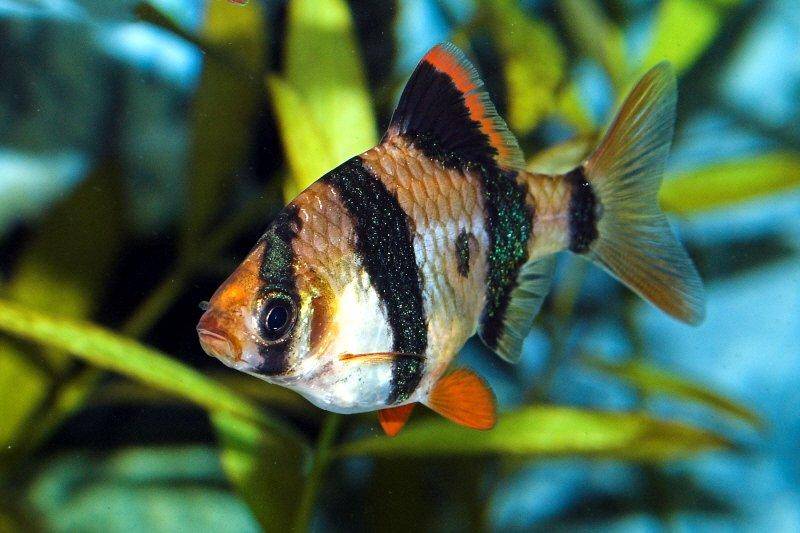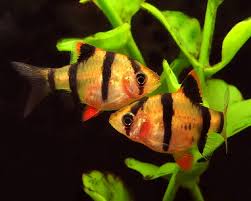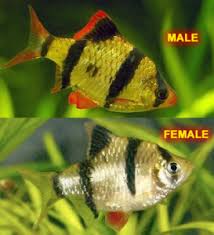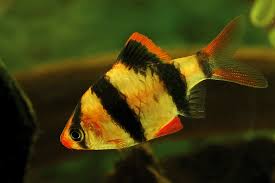Tiger Barb

A vibrant and energetic addition to any freshwater aquarium, the Tiger Barb (Puntigrus tetrazona) is a popular choice for both novice and experienced fishkeepers in the United Kingdom. Known for their striking black stripes and playful, boisterous nature, these fish can provide endless hours of entertainment. However, to truly thrive, they require specific care and conditions. This in-depth guide will walk you through everything you need to know to keep your Tiger Barbs healthy and happy.
From Southeast Asian Streams to Your Aquarium: The Origins of the Tiger Barb
Native to the warm, slow-moving waters of Borneo, Sumatra, and the Malay Peninsula, Tiger Barbs inhabit streams and river tributaries with dense vegetation. These environments are characterised by soft, slightly acidic water. Understanding their natural habitat is key to replicating a suitable environment in your home aquarium.
Setting Up the Perfect Tiger Barb Tank
Creating the right environment is the most crucial step in ensuring the well-being of your Tiger Barbs. These are active fish that require ample space to swim and exhibit their natural schooling behaviour.
Tank Size: A minimum of a 90-litre (20-gallon) tank is recommended for a small school of Tiger Barbs. However, a larger tank of 110 litres (30 gallons) or more is highly preferable, especially if you plan on keeping a larger school or other fish. A longer tank is better than a tall one to provide more horizontal swimming space.
Filtration and Aeration: Good filtration is essential to maintain stable water quality and manage the waste produced by these active fish. An external canister filter or a quality internal filter is recommended. Tiger Barbs also appreciate a moderate water flow, which can be achieved with the filter outlet or the addition of a small powerhead. Good aeration, facilitated by an air stone, will ensure the water is well-oxygenated.
Substrate and Decorations: A fine gravel or sand substrate is ideal. To mimic their natural habitat, provide plenty of live or artificial plants. Live plants such as Java Fern, Anubias, and Cabomba are excellent choices as they are relatively hardy. Include driftwood, rocks, and caves to create hiding places and break up lines of sight. This is particularly important for reducing aggression within the school. Ensure there is still plenty of open water in the middle of the tank for swimming.
Ideal Water Parameters for Thriving Tiger Barbs

Maintaining stable water conditions is vital for the health of your Tiger Barbs. While they are relatively hardy, they will do best in water that closely matches their natural environment.
| Water Parameter | Recommended Range | Notes |
| Temperature | 24-27°C (75-80°F) | A stable temperature is crucial. Use a reliable aquarium heater. |
| pH Level | 6.0 – 7.5 | Slightly acidic to neutral water is preferred. |
| Water Hardness | 5-15 dGH | Softer water is ideal, but they can adapt to slightly harder conditions. |
| Ammonia | 0 ppm | Highly toxic to fish. A fully cycled tank is essential. |
| Nitrite | 0 ppm | Highly toxic to fish. A fully cycled tank is essential. |
| Nitrate | < 20 ppm | Perform regular water changes to keep nitrate levels low. |
Regular water testing using a quality test kit is essential to monitor these parameters and ensure a healthy environment for your fish.
A Balanced Diet for Vibrant Health
Tiger Barbs are omnivores and have a hearty appetite. A varied diet is key to their health, vibrant colouration, and energy levels.
Daily Diet:
- High-Quality Flake or Pellet Food: This should form the staple of their diet. Choose a food specifically formulated for tropical fish.
- Frequency: Feed small amounts two to three times a day, only giving what they can consume within a couple of minutes to avoid overfeeding and water pollution.
Weekly Treats:
- Frozen and Live Foods: Supplement their diet with treats such as brine shrimp, daphnia, and bloodworms. These provide essential proteins and are eagerly devoured.
- Blanched Vegetables: Occasionally offer blanched vegetables like peas (with the skin removed), spinach, or courgette.
Sample Weekly Feeding Schedule
A varied diet keeps your Tiger Barbs engaged and provides a wider range of nutrients.
| Day | Morning Feed | Evening Feed |
| Monday | High-Quality Flake Food | Frozen Brine Shrimp |
| Tuesday | Tropical Pellets | High-Quality Flake Food |
| Wednesday | Blanched Peas | Frozen Bloodworms |
| Thursday | High-Quality Flake Food | Tropical Pellets |
| Friday | Frozen Daphnia | High-Quality Flake Food |
| Saturday | Tropical Pellets | Live Brine Shrimp (if available) |
| Sunday | Fasting Day (optional) |
The Infamous Fin Nippers: Schooling Behaviour and Tank Mates

Tiger Barbs are known for their semi-aggressive nature and their tendency to nip the fins of other fish. This behaviour can be managed by keeping them in appropriate numbers and choosing tank mates carefully.
Schooling: Tiger Barbs are a shoaling species and must be kept in a group of at least six individuals, though a school of eight or more is even better. In a larger group, they will establish a pecking order amongst themselves and are more likely to leave other fish alone. A solitary Tiger Barb will be stressed and much more likely to become aggressive towards its tank mates.
Suitable Tank Mates:
- Other Barbs: Rosy Barbs, Cherry Barbs (in a sufficiently large tank), and other varieties of Tiger Barbs (like the Green or Albino) can make good companions.
- Fast-Moving Fish: Danios, larger Tetras (like Black Skirt or Serpae Tetras), and some Rasboras can often outpace the nipping tendencies of Tiger Barbs.
- Bottom Dwellers: Corydoras catfish and various species of Loach (like the Clown Loach or Yoyo Loach) are generally a good match as they occupy a different level of the tank.
Fish to Avoid:
- Slow-Moving, Long-Finned Fish: Angelfish, Guppies, and Bettas are prime targets for fin nipping and should not be housed with Tiger Barbs.
- Timid or Shy Fish: The boisterous nature of Tiger Barbs can be stressful for more placid species.
Keeping Your Tiger Barbs in Top Condition: Health and Disease
With proper care, Tiger Barbs are generally hardy fish. However, like all aquarium inhabitants, they can be susceptible to common diseases, especially if water conditions are not optimal.
Common Ailments:
- Ich (White Spot Disease): Characterised by small white spots on the body and fins. It is often caused by stress or poor water quality. Treatable with commercially available medications and by raising the tank temperature slightly.
- Fin Rot: Fins appear frayed, ragged, or may have a whitish edge. This is a bacterial infection often linked to poor water quality or injury. Treatment involves addressing the water quality issues and using an antibacterial medication.
- Swim Bladder Disease: Fish may have trouble swimming, floating to the top, or sinking to the bottom. This can be caused by overeating, constipation, or infection. Fasting the fish for a couple of days and then feeding blanched peas can often help.
Prevention is Key: The best way to prevent disease is to maintain excellent water quality through regular water changes, provide a balanced diet, and avoid overcrowding the tank. Quarantining any new fish for at least two to three weeks before introducing them to your main tank is also a crucial preventative measure.
Breeding Tiger Barbs at Home

Breeding Tiger Barbs can be a rewarding experience for the dedicated hobbyist.
Setting up a Breeding Tank: A separate 20-30 litre (5-8 gallon) breeding tank is required. The water should be soft and acidic (pH around 6.5) with a temperature of 26-28°C (79-82°F). The tank should have a bare bottom or a layer of marbles to allow the eggs to fall through and be protected from the parents, who will readily eat them. Fine-leaved plants like Java Moss or a spawning mop should be provided for the female to scatter her eggs on.
Conditioning and Spawning: Condition a healthy, mature pair with a protein-rich diet of live and frozen foods. The female will appear plumper when she is ready to spawn. Introduce the pair to the breeding tank. Spawning usually occurs in the morning, with the female laying several hundred eggs.
Raising the Fry: Once spawning is complete, the parents must be removed from the breeding tank immediately. The eggs will hatch in approximately 36-48 hours. The fry will become free-swimming after a few days and should be fed infusoria or a commercially available liquid fry food until they are large enough to accept newly hatched brine shrimp.
By providing the right environment, a balanced diet, and suitable tank mates, you can enjoy the dynamic and captivating presence of Tiger Barbs in your aquarium for years to come. Their energetic antics and striking appearance make them a truly worthwhile centrepiece for any UK fishkeeper.


